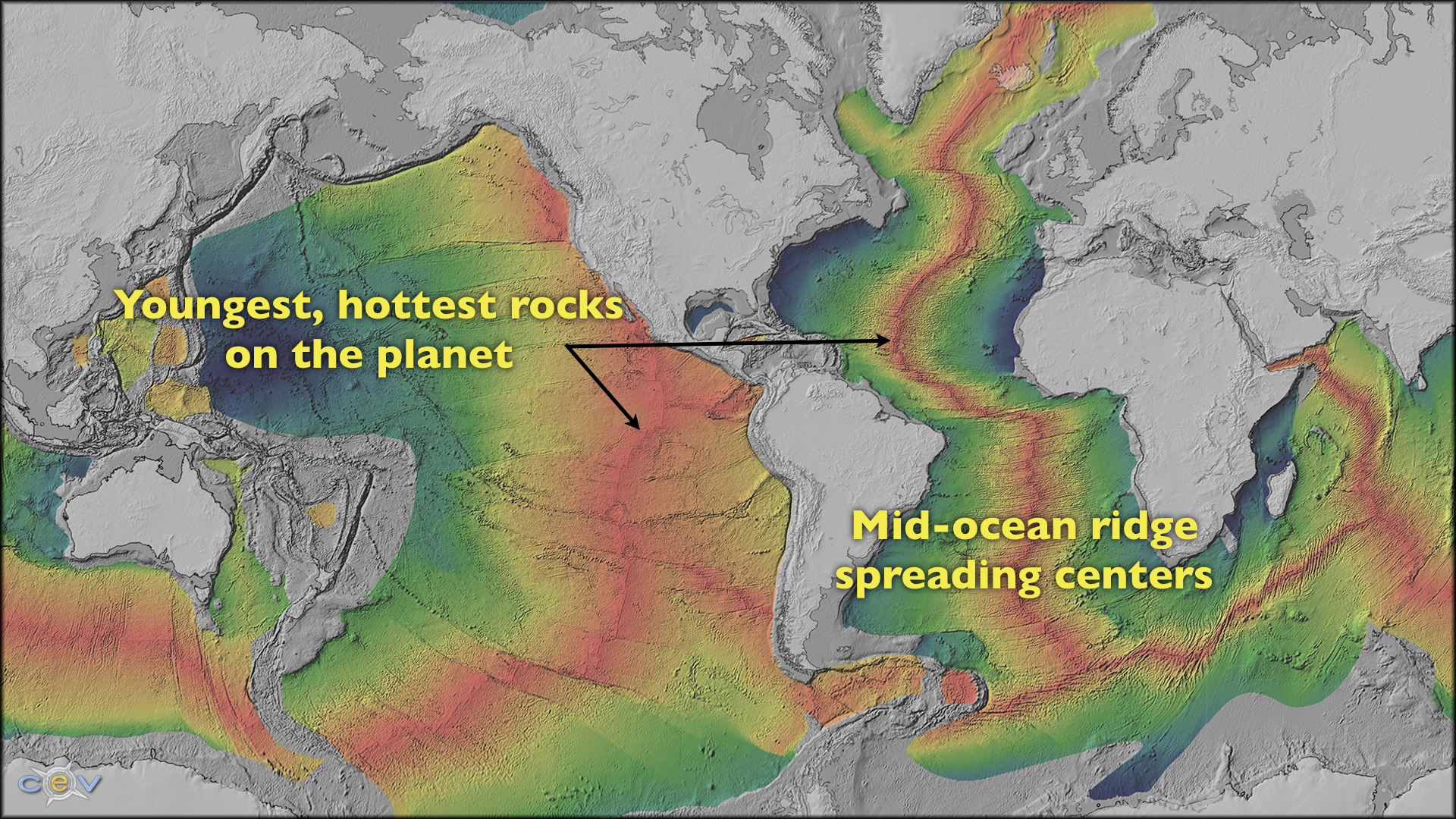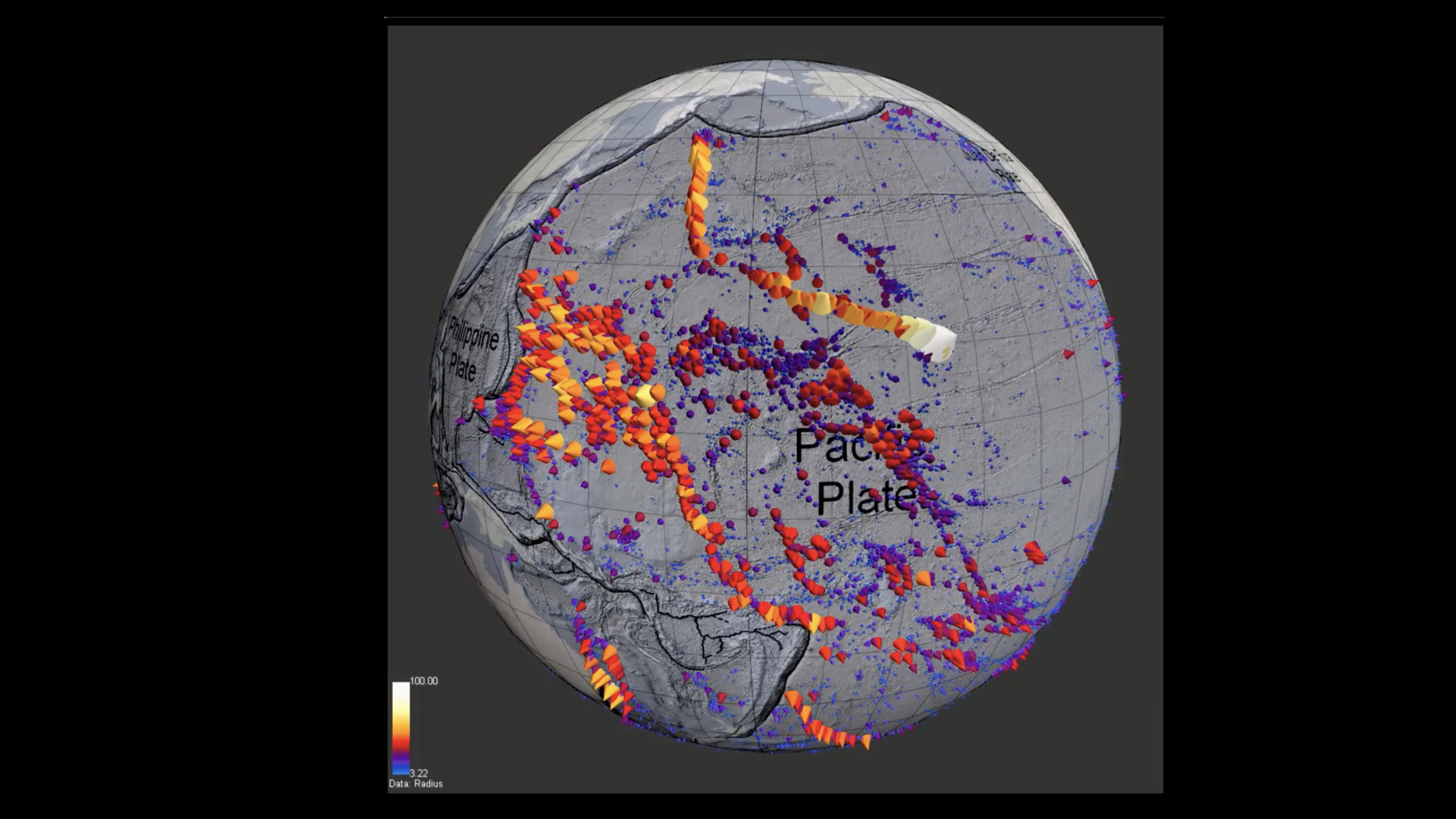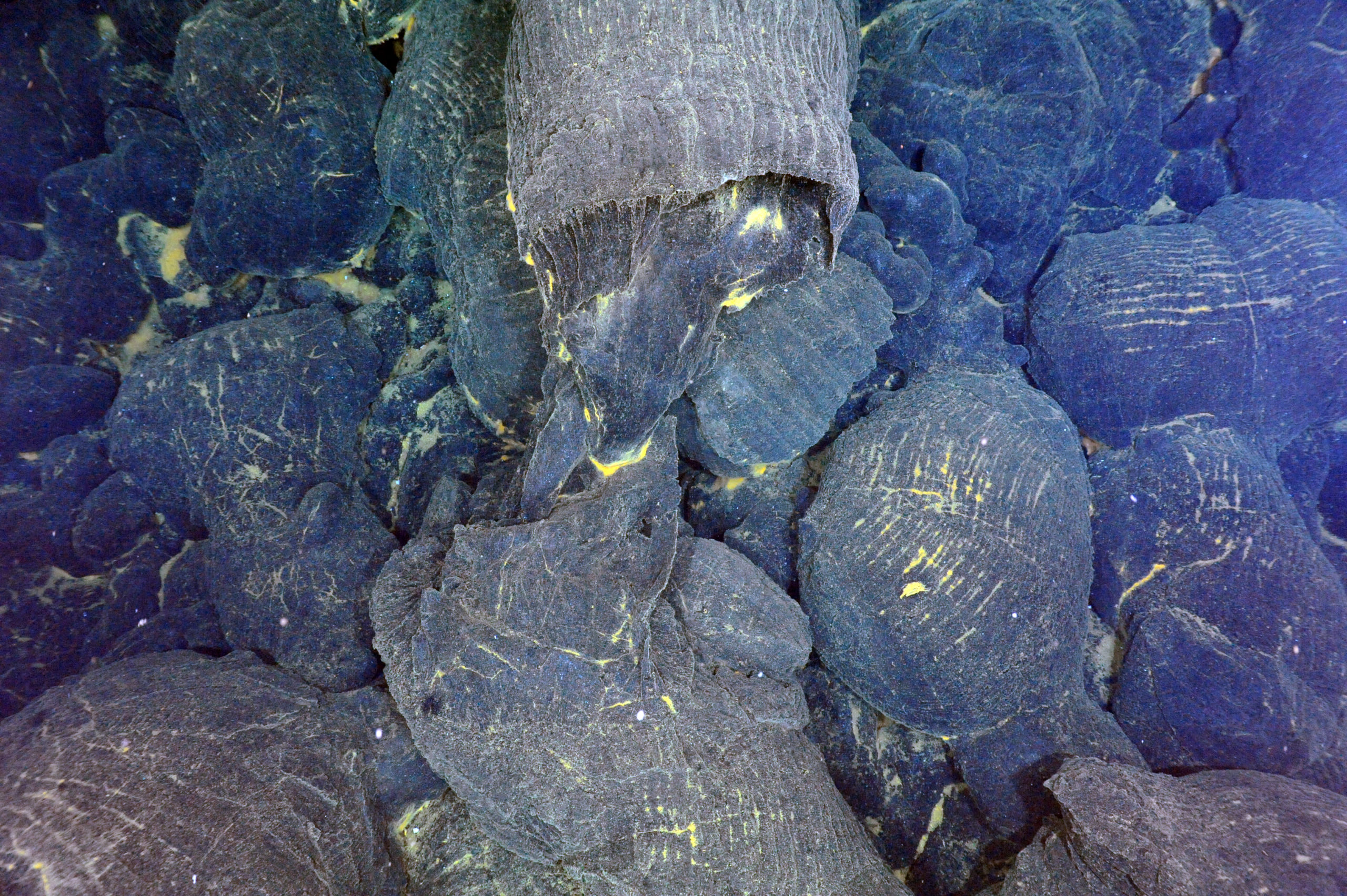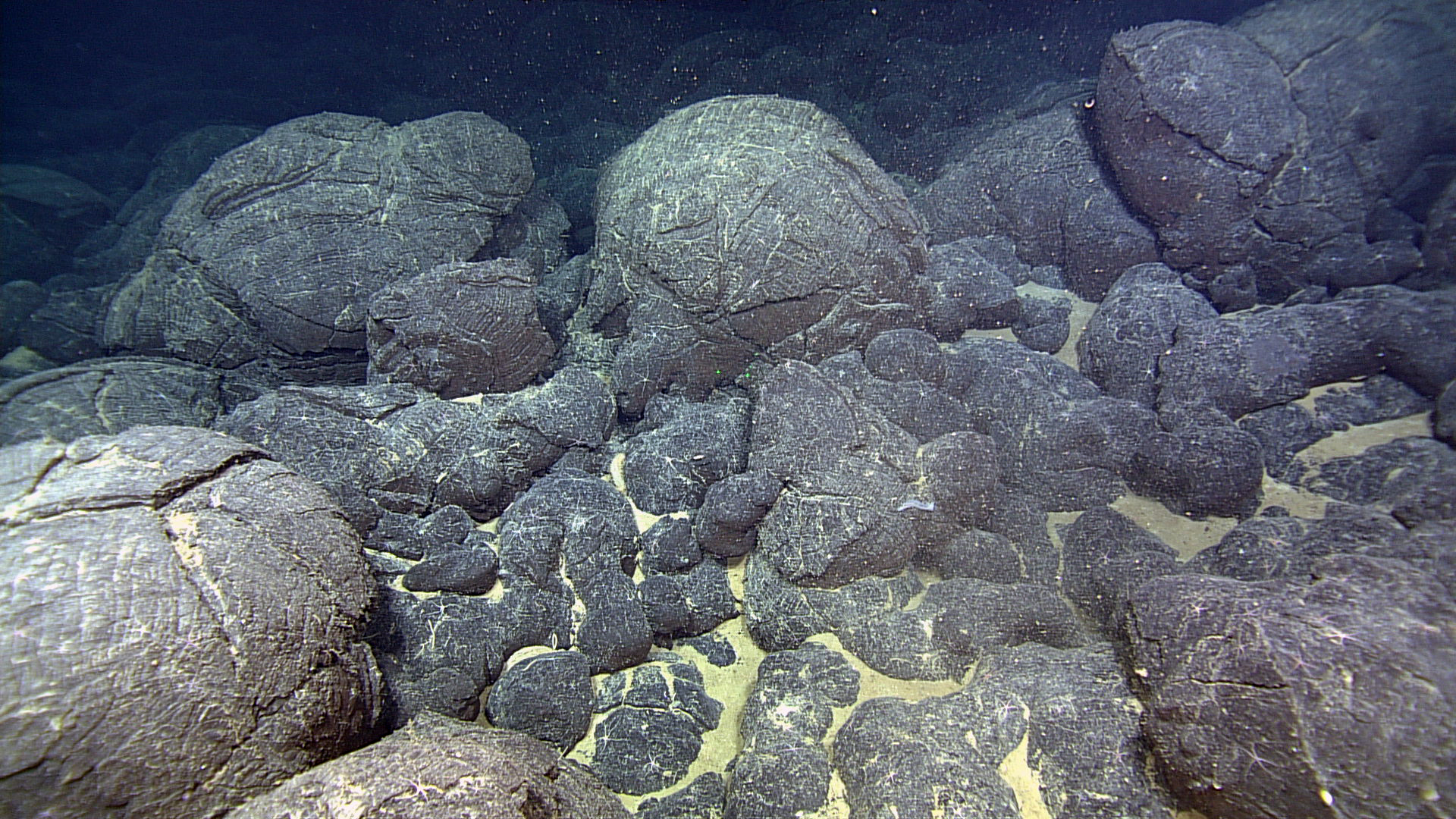Image Archive





























A basic bathymetric map centered on the Juan de Fuca Plate. Credit: Credit: Center for Environmental Visualization, UW.

Convection cells beneath mid-ocean ridges (divergent plate boundaries) are sites where melt rises up from the mantle. At convergent plate boundaries the oceanic crust and sediments are subducted beneath the bounding plate. Credit: Center for Environmental Visualization, UW.

A map of seafloor magnetics highlights the mid-ocean ridge spreading center network that forms the longest mountain chain on Earth. Credit: Center for Environmental Visualization, UW.

volcanoes animation slide

The 70,000 km of the mid-ocean ridge spreading centers forms the longest mountain chain on Earth, and is where 75% of the volcanism on our planet occurs. Credit: Center for Environmental Visualization, University of Washington.

Ocean Structures off the Coast of North America. Credit: D. Kelley, UW

Ocean Plate Environments and Processes. Credit: Center for Environmental Visualization, UW.

Tectonic Plates Around The Globe. Credit: Center for Environemental Visualization, University of Washington.

Thick, yellow bacterial mats colonize basalt flows in the ASHES hydrothermal field at ASHES. dead tube work casings and brittle stars are also observed. Credit: UW/BEOM/WHOI; V21.

Screen shot Extreme Environment Video

The North American Plate off the coast is bounded by four tectonic plates to thw est (Gorda, Juan de Fuca, Pacific, and Explorer. The plates boundaries are defined by the Cascadia Subduction Zone, the Gorda, Juan de Fuca and Explorer mid-mid ocean ridge spreading centers, and a series of transform faults (also known as fracture zones. Environments closer to shore include the shelf, slope and abyssal plain. A seamount chain marks the movement of the Pacific Plate over a "hot spot" on the Juan de Fuca Ridge, and includes the Cobb Seamount guyot. Credit: D. Kelley, University of Washington.

A blue shark visits the ROV ROPOS at the Oregon Offshore site. Credit: UW/NSF-OOI/CSSF; V22.

Very thick white bacterial mats colonize the edges of the collapse zone at Smokey Caverns. A small pocket of clams is near the summit of the collapsed area. Credit: UW/NSF-OOI/WHOI; V18.

Hummocky terrain characterizes the Smokey Taverns site at Southern Hydrate Ridge. White bacterial mats are common on the summits and sides of the hummocks. Rockfish, hagfish and clam chaff dot the landscape. The edge of a large collapse zone is to the right. Credit: UW/NSF-OOI/WHOI; V18 .

A beautiful tube worm with a bright red plume and filamentous bacteria growing on its tube is imaged for the first time during the VISIONS 2005 program. Credit: J. Delaney and D. Kelley, UW/WHOI; V05.

The Milli-Q hydrothermal vent in the Main Endeavour Hydrothermal Field with an incubation experiment near its base. Credit: D. Kelley, University of Washington.

Lightly sedimented pillow flows hosting brittle stars and a coral on Axial Seamount. Credit: UW/NSF-OOI/CSSF; ROPOS Dive R1473; V11.

Frozen fluid lava exits the toe of a pillow basalt on the north face of the >400 ft thick lava flow formed during the 2015 eruption of Axial Seamount. Credit: UW/NSF-OOI/CSSF; V15.

Pillow basalts and sedimented lobate flows at the summit of Axial Seamount. Credit: UW/NSF-OOI/CSSF; V14.

Rat tail fish explore lobate and jumbled lava flows atop Axial Seamount. Credit: UW/NSF-OOI/CSSF; V14.

Beautiful pillow basalts with classic bread crust outer surfaces on Axial Seamount. Credit: UW/NSF-OOI/CSSF; V14.

Cross sectional view of lobate flows and sheet flows on the western wall of Axial Seamouint hosting sea anemones and starfish. Credit: UW/NSF-OOI/ROPOS; V22.

ROPOS_GOING_IN

An overview of Axial Seamount centered on Axial Caldera at ~ 1500 m water depth. Credit: University of Washington.

Mid-ocean ridges and subduction zones form two major plate boundaries on Earth. Credit: Center for Environmental Visualization, University of Washington.

The mid-ocean ridge spreading centers wrap around the Earth like the seam of a baseball and define major plate boundaries. Credit: Center for Environmental Visualization, University of Washington.

boilingcorestillpythias

Bits of white methane hydrate are embedded in the sediment core recovered from beneath the seafloor at Pythais Oasis. Credit: M. Elend, University of Washington.
- Anemone
- Animal
- Arthropod
- ASHES
- Axial
- Axial Base
- Axial Biology
- Axial Caldera
- Bacteria
- Basalt Lava
- BEP
- Biofouling
- biolgoy
- Biology
- Camds
- Camera
- Camhd
- Central Caldera
- Ciliates
- Cnidaria
- Coastal Biology
- Crab
- Deep Profiler Mooring
- Dive Highlights
- Eastern Caldera
- Echinoderms
- Endurance Array
- Engineering Team
- ENLIGHTEN 10
- Exploratorium
- Fish
- Geology
- HD Camera
- HPIES
- Hydrate Ridge
- Hydrates
- Hydrophone
- Hydrothermal Vents
- Illustration
- Inshore 80 Meters
- Instrument
- International District
- J-BOX
- Jason
- Jellyfish
- Junction Box
- K12
- Lava
- Mollusk
- Moorings
- Nodes
- Nudibranch
- Octopus
- OOI
- Oregon Offshore
- Oregon Offshore 600 m
- Oregon Shelf
- Oregon Slope Base
- People
- PN1B
- PN1D
- Polychaetes
- PPSDN
- Primary Node
- RASFL
- ROCLS
- ROPOS
- ROPOS Dives
- ROV Team
- RV Revelle
- RV Sikuliaq
- RV Thompson
- Salp
- Sample
- SC13
- Science Team
- Sea Cucumber
- Sea Star
- Sea Urchin
- Seafloor
- Seismometer
- Sensors
- Shallow Profiler Mooring
- Shark
- Shipboard
- Shore Station
- Slope Base
- Smoker
- Soft Coral
- Southern Hydrate Ridge
- Sponge
- Squid
- Students
- Students & Guest Participants
- Tmpsf
- Tubeworms
- VISIONS 11 Leg 1
- VISIONS 11 Leg 2
- VISIONS 11 Viewers
- VISIONS 13
- VISIONS 14
- VISIONS 15
- VISIONS 16
- VISIONS 17
- VISIONS 18
- VISIONS 20
- VISIONS 22
- VISIONS 23
- Visualization
